Towards a Metamodel to Support the Joint Optimization of Socio Technical Systems
Abstract
:1. Introduction
2. Motivation
3. Goal of the Research, Scope and Paper Organization
4. Method
5. Socio Technical Systems
6. Joint Optimization
Because the social and technical elements must work together to accomplish tasks, work systems produce both physical products and social/psychological outcomes. The key issue is to design work so that the two parts yield positive outcomes; this is called joint optimization [23].
- (1)
- Responsible autonomy individuals/stakeholders take responsibility for the outcome/performance can make decisions autonomously;
- (2)
- Adaptability tasks and schedules and overall work procedures can be adjusted by individual team members to increase optimization (distributed optimization vs. central optimization);
- (3)
- (4)
- Feedback loops and recursive interactions [28].
7. About Models and Meta Models
8. JOM—A Metamodel for the Joint Optimization of Socio Technical Systems
- (1)
- In Tracing the Roots: The Influence of Socio Technical Principles on Modern Organizational Change, Munkvold [37] distinguishes between Social Aspects such as Attributes of people (attitudes, skills, values, etc.) their Relationships among people, Reward systems, Authority, structures and Technical Aspects, such as Processes, tasks, technology. In this approach, however, the two are still considered somewhat “separate”;
- (2)
- In Metamodel for Understanding, Analyzing, and Designing Sociotechnical Systems, Alter [38] formulates a valid integrated metamodel expressed as a technical artifact (a series of diagrams capturing the core socio technical system’s entities and processes). It doesn’t however—surprisingly perhaps—directly address “joint optimization” as a requirement for effective STS and does not support JO as a continuum, which this research targets and emphasizes as an essential inextricable triad of entities in STS. Furthermore, the STS is viewed primarily as a “work system”, while in our research STS are considered irrespective of whether the goal is productivity—as in Alters [39] work system—or not. Our approach incorporates some of the core entities and processes identified in this model, albeit rearranged and with a higher level of abstraction;
- (3)
- In Organizational Transformation a Model for Joint Optimization of Culture Change and Evidence Based Design, Hamilton et al. [40] provide a narrative form a model for joint optimization, with focus on cultural change in the context of evidence based research, however the outcome of the analysis is not codified and does not yield a technical artifact that can be used by developers to guide practical implementations of joint optimization;
- (4)
- In Putting Action into Sociotechnical Systems Theory—a proposed analysis of the Australian Film Industry Socio technical action regulation using START [41] draws from the People Technology Organization (PTO) framework. The model is domain specific with the focus on an “industry”, that is a cluster of companies operating in the same field. It identifies four levels of organizations. The model proposed here does not draw from this approach at this stage;
- (5)
- One of the frameworks of reference used to capture high level aspect of STS is found in Shaping socio technical System Innovation Strategies using a Five Aspects Taxonomy by Rhodes and Ross [42]. The Taxonomy identifies and models five aspects common to most socio technical systems: structural, behavioral, contextual, temporal, and perceptual aspects. According to its proponents, the taxonomy is used to characterize methods to ensure coverage of essential aspects of engineering complex systems, to provide a focusing framework to develop and select systems engineering innovation strategies and an organizing structure for classifying methodological research projects. JOM considers the five aspects as possible facets and interpretive lenses, used mostly as conceptual reference and for model evaluation.
8.1. JOM (V1)
8.2. JOM Vision and Concepts
8.3. JOM Architecture
- -
- Core Entities and relations;
- -
- Core STS Tasks;
- -
- Core Processes.
8.4. Extended Boundary
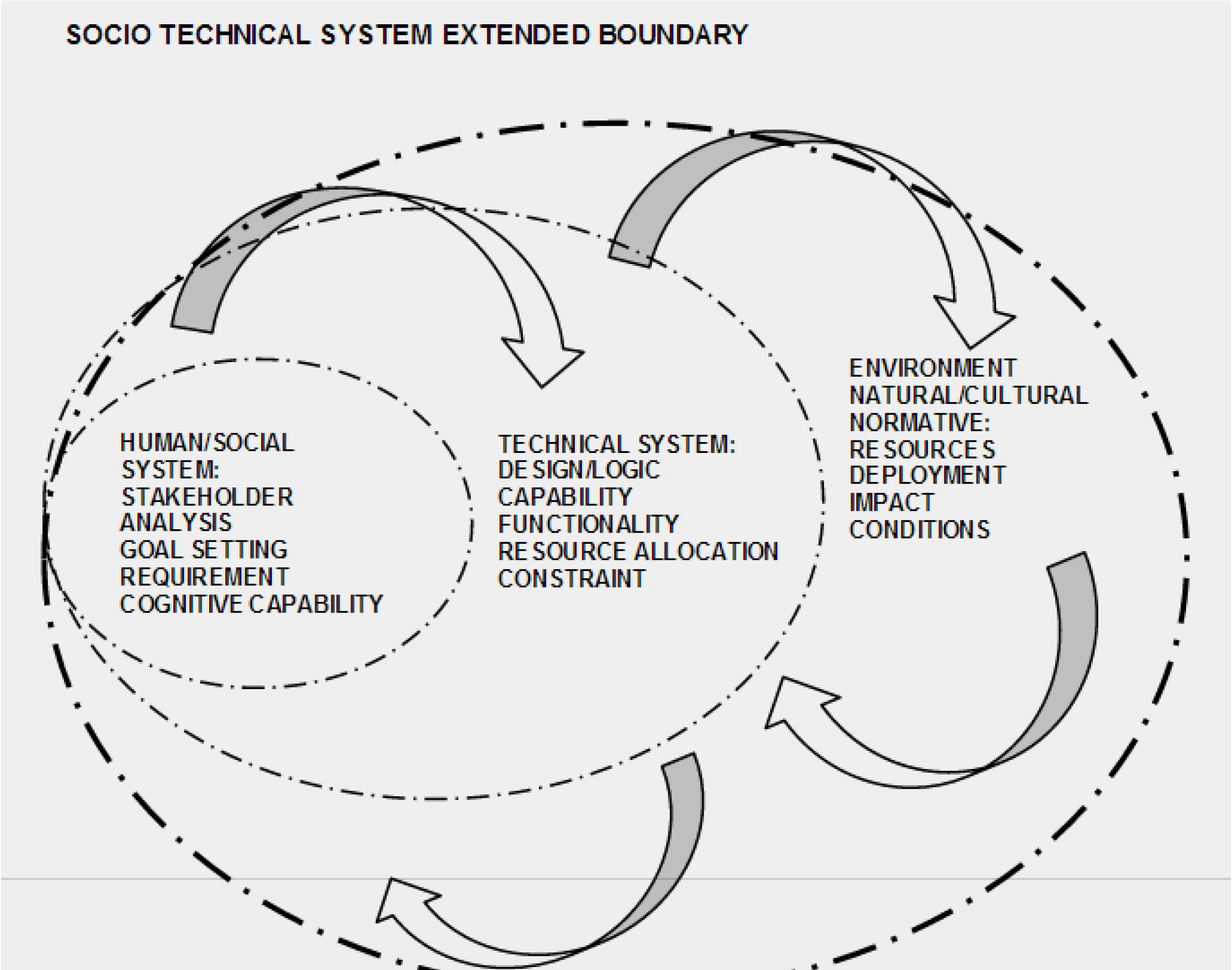
8.5. Core Entities
| Core Entity | Social/Human | Technical | Environment |
|---|---|---|---|
| Stakeholder | X | X | X |
| Goal/Requirements | X | X | X |
| Culture | X | X | X |
| Task (Function/Process) | X | X | X |
| Resource/Input | X | X | X |
| Resource/Output | X | X | X |
| Feedback | X | X | X |
| Customers are recipients of a work system’s products and services for purposes other than performing work activities within the work system. For example, a doctor who receives a lab result while treating a patient might be viewed as a customer of the lab, but is not a customer of the work system of providing medical care. Internal customers are customers of a work system who happen to be employees or contractors of the firm within which the work system operates. External customers are not employees or contractors for that firm. |
| Products and services are the physical things, information, and actions that are received or used by the work system’s customers and that provide direct benefit for its customers. Different groups of customers may benefit from different products and services produced by the work system. |
| Processes and activities are actions that occur within the work system to produce products and services for its customers. Processes and activities include much more than totally structured processes that appear in some IS definitions as “procedures”. As happens in collaboration systems and many other situations, various processes and activities performed by participants may be structured, semi-structured, or unstructured. |
| Participants are people who do the work within the work system. They include both IT users and non-users. Thus, non-users of IT may still be important to include as participants in the work system. A work systems’s customers are also participants in many work systems that provide services. In self-service work systems, customers may be the only participants. |
| Information includes codified and non-codified information created and/or used by a work system. |
| Technologies include tools that are used by work system participants, plus other tools that perform totally automated activities. Technologies within a work system include IT and other, non-IT technologies that perform physical movements or transformations that are visible to users. Many technologies that perform physical activities (e.g., automobiles and microwave ovens) include embedded IT. |
| Infrastructure includes relevant human, information, and technical resources that are used by the work system but are managed outside of it and are shared with other work systems. |
| Environment includes the relevant organizational, cultural, competitive, technical, and regulatory environment within which the work system operates. A work system’s environment should be considered when analyzing a work system because its success depends partly on surrounding factors that are not part of the work system itself. |
| Strategies that are relevant to a work system include strategies of the work system, the organization, and the enterprise. Strategies may or may not be articulated. When articulated, strategies may help in understanding a work system and its environment. |
| Customers, Participants = Stakeholder Products Processes and activities = Process Strategy = Culture Information = Resource Infrastructure = Resource |
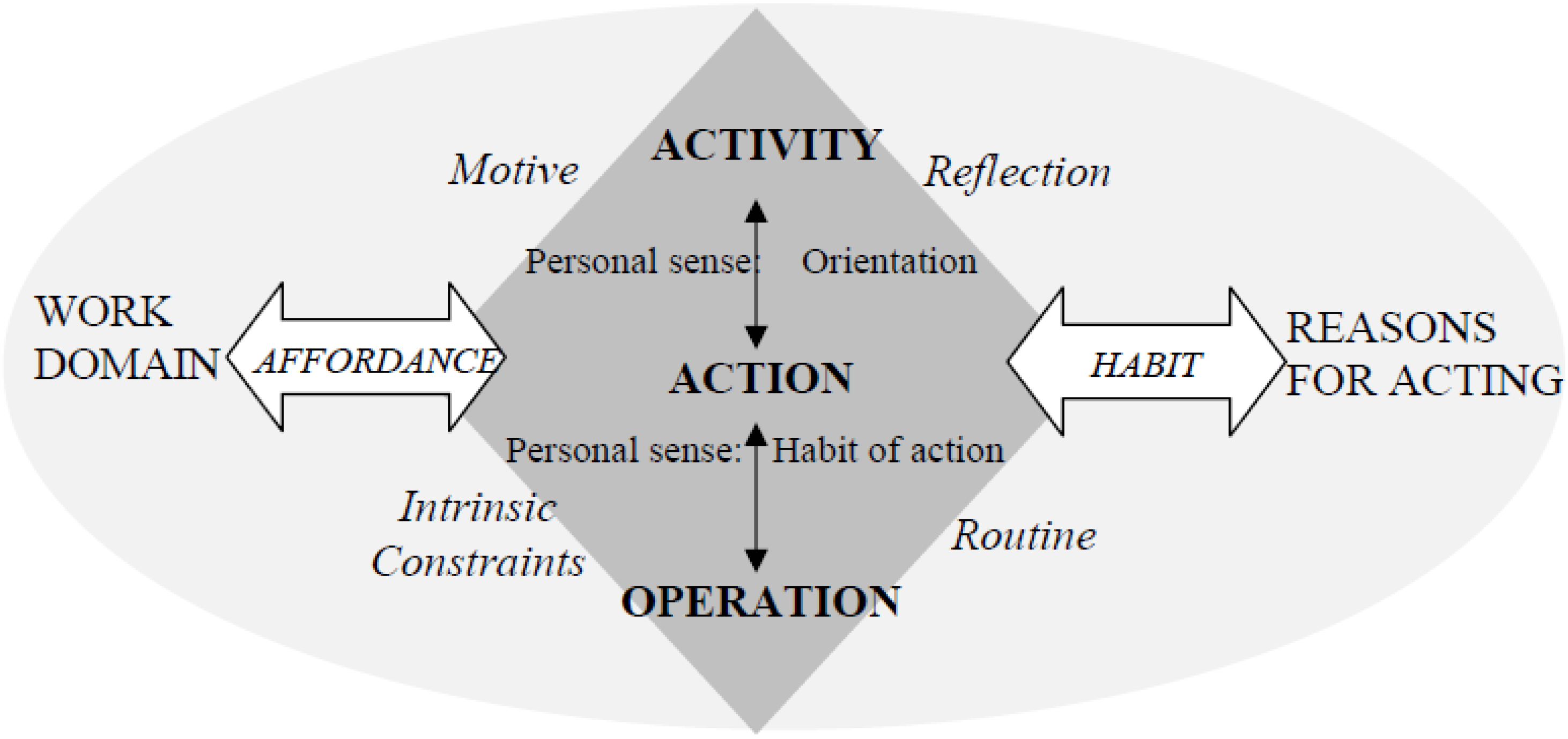
8.6. Core Dynamic Relations
- -
- There is a dependency between an entity and any other entity or attribute or part of the system;
- -
- There is a communication flow (exchange of data, information or other resource) between entities and any other dimension or part of the system.
8.7. Core STS Process
- (1)
- Support the development of a STS, by ensuring that (a) comprehensive stakeholder perspective is adhered to; and (b) each phase of the system development process is carried out iteratively taking into the account as input the output of the precedent phase;
- (2)
- To ensure that the STS which is the outcome of JOM core process, adheres to its blueprint, IE, that replicates its core structure and features;
-
- Identify stakeholders;
-
- Stakeholder define goals, expected outcomes and boundaries STS boundary;
-
- (What should be in the system, stakeholder, technology and environment);
-
- Align goals to optimize resource allocation;
-
- Define STS components, functions, behaviors;
-
- Identify STS dynamics/flows;
-
- Outline process to achieve goal/expected outcomes;
-
- Iterate until goal is achieved.
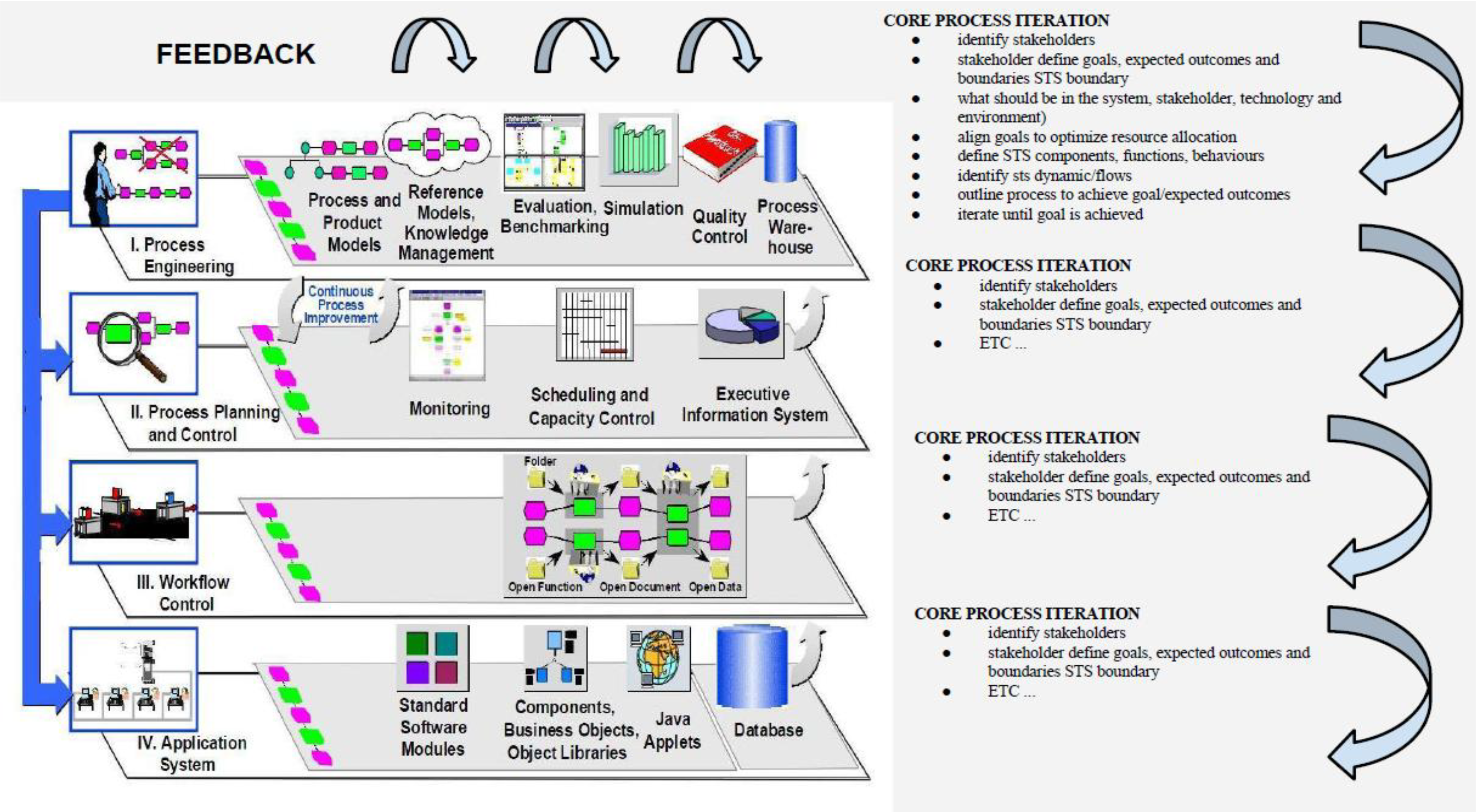
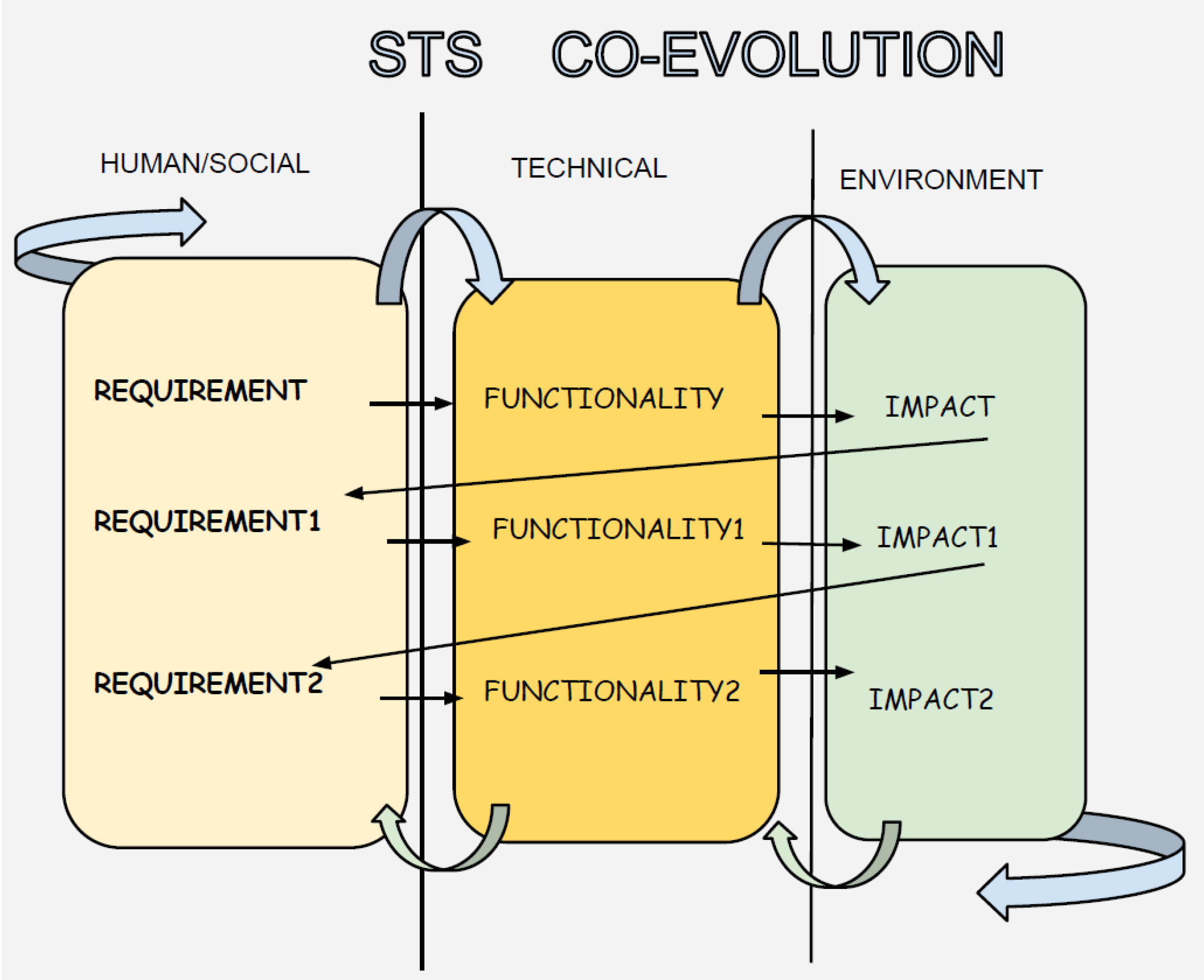
8.8. Extensions
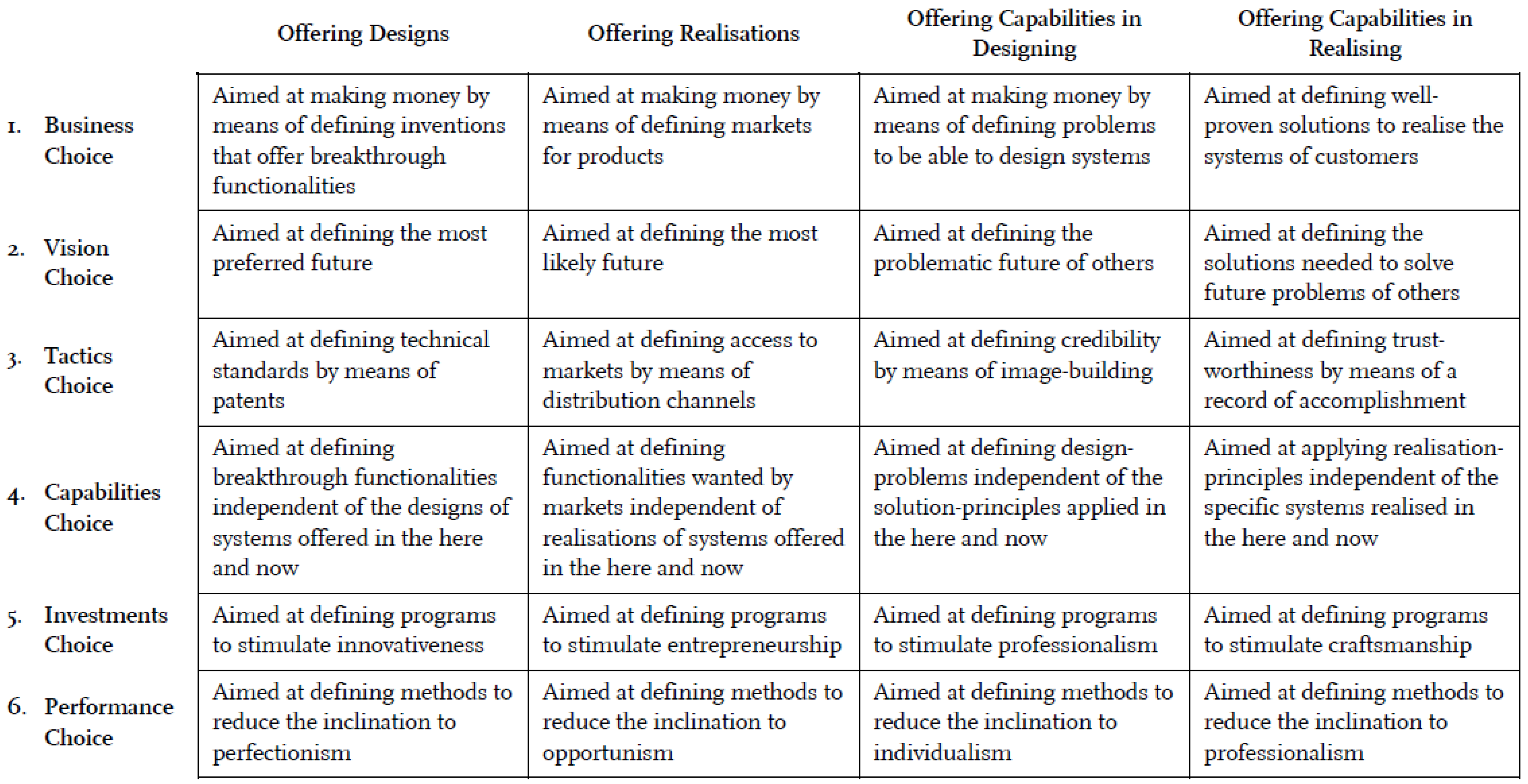
9. Summary Overview of JOM
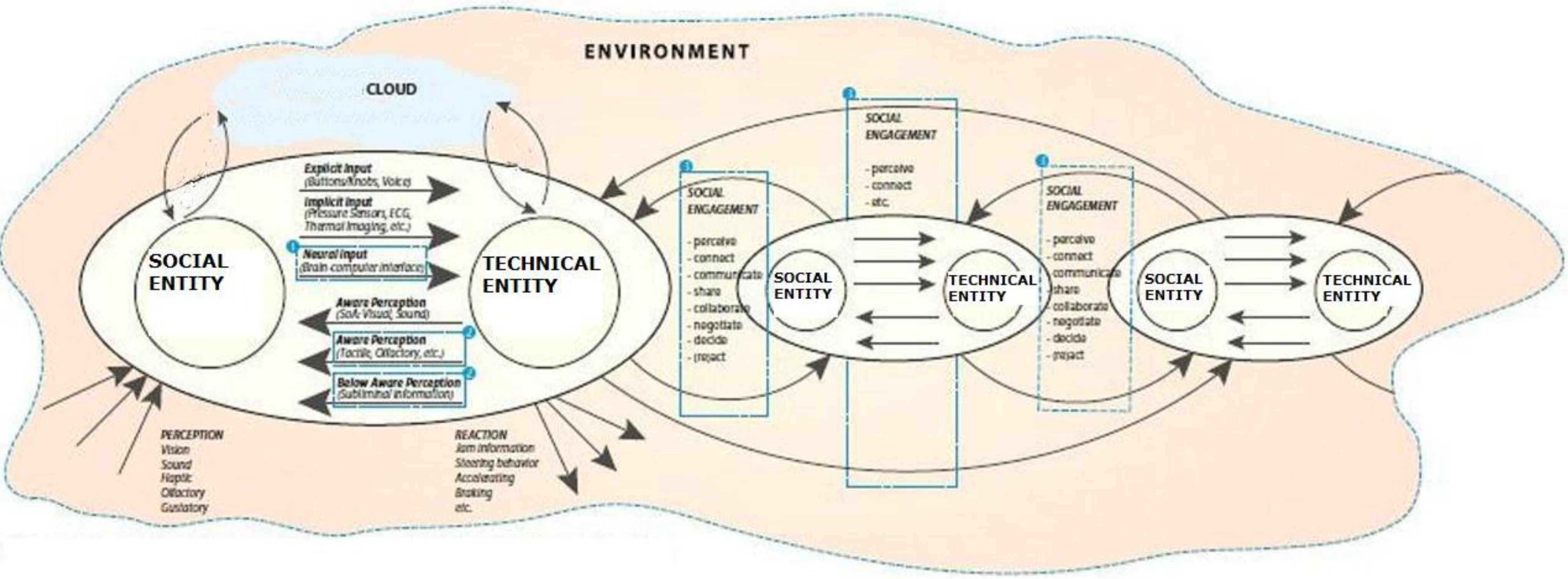
10. Evaluation
-
- Does JOM help joint optimization?
-
- Does JOM describe joint optimization of STS?
-
- How can JO be evaluated?
-
- What are the tangible indicators of JO?

11. How to Use JOM
12. JEO, and the Joint Optimization of Ontology Development
- (1)
- The development of ontologies—also known as ontology engineering—inevitably relies on a diverse set of humans who make decisions in relation to goals, scope, methods, requirements, desired functionalities, etc., but also to its management (costing, resourcing);
- (2)
- The deployment of ontologies, in the majority of cases, impacts humans because it determines the functionalities and behaviors of information systems that people increasingly depend on for their daily lives.
- (1)
- Identify stakeholders, outline stakeholder profile;
- (2)
- Define the purpose of the ontology (emphasis on representation/indexing, problem solving/reasoning);
- (3)
- Outline requirements;
- (4)
- Identify and survey existing knowledge sources and existing ontologies, elicit existing knowledge Assess why the existing knowledge resources do not meet the intended user requirements, update the requirements with the output of activities above (iterative);
- (5)
- Scoping ontology (defining the boundaries and level of granularity, according to goal and stakeholders requirements) Update the requirements (iterative);
- (6)
- Devise and implement quality assurance plan Add quality parameters to the requirements (iterative);
- (7)
- Define the field of competence to identify the knowledge boundaries (competence questions) Match the field of competence with the knowledge sources;
- (8)
- Define the ontology artifacts: Vocabulary Identify concepts/entities/classes relations, axioms Refine and map vocabularies to artifacts;
- (9)
- Transfer concepts to ontology language representation: Select knowledge representation formalisms and annotation depending on stakeholder requirements, scope and goal;
- (10)
- Deploy/systems integration (modular, incremental);
- (11)
- Testing Evaluation quality monitoring competence assessment;
- (12)
- Publishing;
- (13)
- Maintenance/Reuse.
- Stakeholder—where the widest possible stakeholder base in identified and included in the process;
- Goal/Requirements—where each set of stakeholders contribute to define;
- Task (Function/Process)—various tasks are identified;
- Resource/Input—stakeholders inputs and knowledge sources;
- Resource/Output—artifacts;
- Feedback—iterations of all phases.
13. Limitations
14. Conclusions and Future Work
Conflicts of Interest
References
- Hollnagel, E. Understanding Accidents—From Root Causes to Performance Variability. In Proceedings of the 7th IEEE Conference on Human Factors and Power Plants, Scottsdale, AZ, USA, 15–19 September 2002.
- Lock, S. The management of Socio Technical Systems using configuration modeling. Hum. Syst. Manag. 2004, 23, 29–47. [Google Scholar]
- François, C. Systemics and cybernetics in a historical perspective. Syst. Res. Behav. Sci. 1999, 16, 203–219. [Google Scholar] [CrossRef]
- Von Bertalanffy, L. An outline of general system theory. Br. J. Philos. Sci. 1950, 1, 134–165. [Google Scholar] [CrossRef]
- Stanton, N.A. Human Factors Methods: A Practical Guide for Engineering and Design; Ashgate Publishing: Farnham, UK, 2012. [Google Scholar]
- Baxter, G.; Sommerville, I. Socio Technical Systems: From design methods to systems engineering. Interact. Comput. 2011, 23, 4–17. [Google Scholar] [CrossRef]
- Qureshi, Z.H. A Review of Accident Modelling Approaches for Complex Critical Sociotechnical Systems. Available online: http://crpit.com/confpapers/CRPITV86Qureshi.pdf (accessed on 30 January 2014).
- Heylighen, F. The science of self-organization and adaptivity. Encycl. Life Support Syst. 2001, 5, 253–280. [Google Scholar]
- Cohen, M.D.; Riolo, R.L.; Axelrod, R. The Emergence of Social Organization in the Prisoner’s Dilemma: How Context-Preservation and Other Factors Promote Cooperation. Available online: http://www.santafe.edu/media/workingpapers/99-01-002.pdf (accessed on 30 January 2014).
- Henry, C.L. Why Information Systems Fail. Columbia University Press: New York, NY, USA, 1975; (658.403/LUC). [Google Scholar]
- IBM Research. Available online: http://www.research.ibm.com/cognitive-computing/index.shtml#fbid=ucEfSn05Oru (accessed on 30 January 2014).
- Mitchell, V.L.; Nault, B.R. The Emergence of Functional Knowledge in Sociotechnical Systems; Haskayne School of Business, University of Calgary: Calgary, Canada, 2003. [Google Scholar]
- Fischer, J.; Amekudzi, A. Quality of life, sustainable civil infrastructure and sustainable development. J. Urban Plan. Dev. 2011, 137, 39–48. [Google Scholar] [CrossRef]
- Sussman, J. Today’s Sociotechnical Problems Require a New Field of Study. The Annual Charles L. Miller Lecture. 2012. Available online: http://esd.mit.edu/Headline/calendar/2012/042512millerlecture.html (accessed on 30 January 2014).
- Priscoli, J.D. Retraining the modern civil engineer. Environmentalist 1983, 3, 137–146. [Google Scholar] [CrossRef]
- Vespignani, A. Modelling dynamical processes. Complex Soc. Tech. Syst. Nat. Phys. 2011. [Google Scholar] [CrossRef]
- Grenville, N.D. A Sociotechnical Approach to Evaluating the Effects of Managerial Time Allotment on Department Performance. Master Thesis. Available online: http://scholar.lib.vt.edu/theses/available/etd-534692039701091/unrestricted/Etd.pdf (accessed on 30 January 2014).
- Trist, E.L.; Bamforth, K.W. Some social and psychological consequences of the Longwall method. Hum. Relat. 1951, 4, 3–38. [Google Scholar] [CrossRef]
- Giese, H.; Brun, Y.J.; Serugendo, D.M.; Gacek, C.; Kienle, H.; Müller, H.; Pezzè, M.; Shaw, M. Engineering Self-Adaptive and Self-Managing Systems; Springer-Verlag: Berlinn-Heidelberg, Germany, 2009. [Google Scholar]
- Trist, E. The Evolution of Socio Technical Systems; Ontario Ministry of Labour, Ontario Quality of Working Life Centre: Toronto, Canada, 1981. [Google Scholar]
- Jenkins, D.P.; Stanton, N.A.; Walker, G.H.; Salmo, P.M. Command and Control: The Sociotechnical Perspective; The Sociotechnical Human Factors in Defence; AshGate Publishing: Farnham, UK, 2009. [Google Scholar]
- Davis, L.E. Evolving alternative organization designs: Their sociotechnical bases. Hum. Relat. 1977, 30, 261–273. [Google Scholar] [CrossRef]
- Appelbaum, S.H. Socio Technical systems theory: An intervention strategy for organizational development. Manag. Decis. 1997, 35, 452–463. [Google Scholar] [CrossRef]
- Van de ven, A.H.; Joyce, W.F. Overview of Perspectives on Organization Design and Behavior. In Perspectives on Organization Design and Behavior; John Wiley and Sons: New York, NY, USA, 1981. [Google Scholar]
- Pasmore, W.; Francis, F.; Haldeman, J.; Shani, A. Sociotechnical systems: A North American reflection on empirical studies of the seventies. Hum. Relat. 1982, 35, 1179–1204. [Google Scholar] [CrossRef]
- Hackman, J.R.; Oldham, G.R. Motivation through the design of work: Test of a theory. Organ. Behav. Hum. Perform. 1976, 16, 250–279. [Google Scholar] [CrossRef]
- Sitter, L.U.; Hertog, J.F.; Dankbaar, B. From complex organizations with simple jobs to simple organizations with complex jobs. Hum. Relat. 1997, 50, 497–536. [Google Scholar]
- Carvalho, P.V.R.D. Ergonomic field studies in a nuclear power plant control room. Prog. Nucl. Energy 2006, 48, 51–69. [Google Scholar] [CrossRef]
- Cherns, A.B. Principles of sociotechnical design revisited. Hum. Relat. 1987, 40, 153–162. [Google Scholar] [CrossRef]
- Fishwick, P.A. Toward a Convergence of Systems and Software Engineering. Available online: http://citeseerx.ist.psu.edu/viewdoc/download?doi=10.1.1.40.3999&rep=rep1&type=pdf (accessed on 30 January 2014).
- Doets, K. Basic Model Theory; CLSI Publications: Stanford, CA, USA, 1996. [Google Scholar]
- Smiraglia, R.P. The progress of theory in knowledge organization. Libr. Trends 2002, 50, 330–349. [Google Scholar]
- Cunningham, Ward. Object vs. Model. 2010. Available online: http://c2.com/cgi/wiki?ObjectVsModel (accessed on January 2014).
- Ernst, J. What is Metamodeling, and What is it Good for? Available online: http://infogrid.org/trac/wiki/Reference/WhatIsMetaModeling (accessed on 30 January 2014).
- Benoit, C. A Tutorial about Metamodeling Using OMG Norms and Eclipse Modeling University of Rennes 1 (IRISA & ESIR). 2012. Available online: http://people.irisa.fr/Benoit.Combemale/teaching/mde/MetamodelingWithEclipseModelingTutorial-2x2.pdf (accessed on 30 January 2014).
- Meta Object Facility (MOF). Available online: http://www.omg.org/mof/ (accessed on 30 January 2014).
- Munkvold, B.E. Tracing the Roots: The Influence of Socio Technical Principles on Modern Organisational Change Practicesin Coakes. In The New SocioTech; Springer: London, UK, 2000. [Google Scholar]
- Alter, S. Metamodel for Understanding, Analyzing, and Designing Sociotechnical Systems. Proceedings of the JAIS Theory Development Workshop, Phoenix, AZ, USA, December 2009; Available online: http://sprouts.aisnet.org/9-59 (accessed on 30 January 2014).
- Alter, S. The work system method for understanding information systems and information systems research. Commun. Assoc. Inf. Syst. 2002, 9, 90–104. [Google Scholar]
- Hamilton, D.; Orr, K.; Diane, R.; Ellen, W. Organizational transformation: A model for joint optimization of culture change and evidence-based design HERD. Health Environ. Res. Des. J. 2007, 1, 40–60. [Google Scholar]
- Jones, M.L. Putting Action into Sociotechnical Systems Theory—A Proposed Analysis of the Australian Film Industry Using START. In Proceedings of Transformational Tools for the 21st Century Conference (TT21C2006), Rockhampton, Australia, 24 October 2006; pp. 64–74.
- Rhodes, D.H.; Ross, A.M. Shaping Socio Technical System Innovation Strategies Using a Five Aspects Taxonomy. 2010. Available online: http://seari.mit.edu/documents/preprints/RHODES_EUSEC10.pdf (accessed on 30 January 2014).
- Laracy, J.R. Addressing system boundary issues in complex socio technical systems. Syst. Res. Forum 2007, 2. [Google Scholar] [CrossRef]
- Heidegger, M. Being and Time; Harper & Row (Originally published in German, in 1927): New York, NY, USA, 1962. [Google Scholar]
- Edwards, M.G. The integral holon: A holonomic approach to organisational change and transformation. J. Organ. Chang. Manag. 2005, 18, 269–288. [Google Scholar] [CrossRef]
- Wells, S.; McLean, J. One Way Forward to beat the Newtonian habit with a complexity perspective on organisational change. Systems 2013, 1, 66–84. [Google Scholar] [CrossRef]
- Midgley, G. The sacred and profane in critical systems thinking. Syst. Pract. 1992, 5, 5–16. [Google Scholar] [CrossRef]
- Alexander, I.F. A taxonomy of stakeholders human roles in system development. Int. J. Technol. Hum. Interact. 2005, 1, 23–59. [Google Scholar] [CrossRef]
- Ya, S.; Rui, T. The Influence of Stakeholders on Technology Innovation: A Case Study from China. In Proceedings of the 2006 IEEE International Conference on Management of Innovation and Technology, Singapore, 21–23 June 2006.
- Yang, L.-R.; O’Connor, J.T.; Chen, J.-H. Assessment of automation and integration technology’s impacts on project stakeholder success. Autom. Constr. 2007, 16, 725–733. [Google Scholar] [CrossRef]
- Hughes, R. Environmental Impact Assessment and Stakeholder Involvement; IIED: London, UK, 1998. [Google Scholar]
- Woodard, D.G. Is the Natural Environment a Stakeholder? Of Course it is (no Matter What the Utilitarians Might Say)! In Proceedings of the Critical Perspectives on Accounting Conference, New York, NY, USA, 25–27 April 2002.
- Steensma, H.K.; Marino, L.; Weaver, K.M.; Dickson, P.H. The influence of national culture on the formation of technology alliances by entrepreneurial firms. Acad. Manag. J. 2000, 43, 951–973. [Google Scholar] [CrossRef]
- Thorburn, G.L.S. Technology and Culture: A Circle of Influence. 2010. Available online: http://nuglobalstudies.wordpress.com/global-studies/gls_499-2/ (accessed on 30 January 2014).
- Weick, K.E. Organizational culture as a source of high reliability. Calif. Manag. Rev. 1987, 29, 112–127. [Google Scholar] [CrossRef]
- Norros, L. Acting under Uncertainty. The Core-Task Analysis in Ecological Study of Work. 2004. Volume Publications 546. Available online: http://www.vtt.fi/inf/pdf (accessed on 30 January 2014).
- Scheer, A.W.; Nüttgens, M. ARIS Architecture and Reference Models for Business Process Management; Springer: Berlin/Heidelberg, Germany, 2000. [Google Scholar]
- Per, K.; Kruchten, P. The Rational Unified Process Made Easy: A Practitioner’s Guide to the RUP; Addison-Wesley Professional: Boston, MA, USA, 2003. [Google Scholar]
- Vos, J.-P. The Making of Strategic Realities: An Application of the Social Systems Theory of Niklas Luhmann; Technische Universiteit Eindhoven: Eindhoven, The Netherlands, 2002. [Google Scholar]
- Riener, A.; Ferscha, A. Enhancing Future Mass ICT with Social Capabilities. Co-Evolution of Intelligent Socio Technical Systems; Springer: Berlin/Heidelberg, Germany, 2013; pp. 141–184. [Google Scholar]
- Di Maio, P. ‘Just Enough’ Ontology Engineering. Proceedings of the International Conference on Web Intelligence, Mining and Semantics, Sogndal, Norway, 25–27 May 2011.
- Di Maio, P. Towards Just Enough Ontology Engineering. Cutter Consortium Reports. 2009. Available online: http://www.cutter.com/bia/fulltext/reports/2009/03/index.html (accessed on 30 January 2014).
- Di Maio, P. Just Enough Ontology for Innovation in Systems Engineering. 2010. Available online: http://www.incose.se/eusec2010/Tutorial%203%20Just%20Enough%20Ontology%20for%20Innovation%20in%20Systems%20Engineering.pdf (accessed on 30 January 2014).
- Di Maio, P. Just Enough Ontology. UK Ontology Network. 2014. Available online: http://ced.aston.ac.uk/ukont2014/programme.html (accessed on 30 January 2014).
© 2014 by the authors; licensee MDPI, Basel, Switzerland. This article is an open access article distributed under the terms and conditions of the Creative Commons Attribution license (http://creativecommons.org/licenses/by/3.0/).
Share and Cite
Di Maio, P. Towards a Metamodel to Support the Joint Optimization of Socio Technical Systems. Systems 2014, 2, 273-296. https://doi.org/10.3390/systems2030273
Di Maio P. Towards a Metamodel to Support the Joint Optimization of Socio Technical Systems. Systems. 2014; 2(3):273-296. https://doi.org/10.3390/systems2030273
Chicago/Turabian StyleDi Maio, Paola. 2014. "Towards a Metamodel to Support the Joint Optimization of Socio Technical Systems" Systems 2, no. 3: 273-296. https://doi.org/10.3390/systems2030273
APA StyleDi Maio, P. (2014). Towards a Metamodel to Support the Joint Optimization of Socio Technical Systems. Systems, 2(3), 273-296. https://doi.org/10.3390/systems2030273





